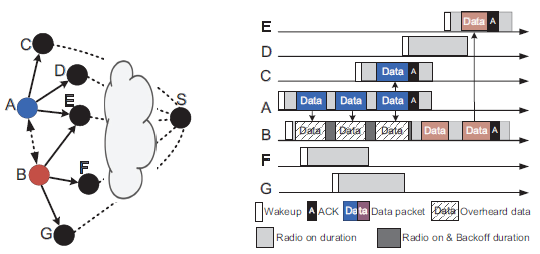Researches
Ad Hoc Networking
SmarTiSCH: An Interference-Aware Engine for IEEE 802.15.4e-based Networks

Time-Slotted Channel Hopping (TSCH) is a popular link-layer protocol defined in the IEEE 802.15.4e standard that improves the reliability and throughput of wireless sensor networks by exploiting diversity in both time and frequency. Despite the body of literature proposing several scheduling schemes for TSCH, a gap yet to be filled is the design of an effective way to deal with internal and external interference, which are both known to strongly affect communication performance. In fact, existing works either make use of a fixed schedule (and hence cannot cope with interference), or require extra control traffic (and hence increase energy consumption). We propose SmarTiSCH, an interference-aware engine for IEEE 802.15.4e-based networks that retains the simplicity and energy-efficiency of autonomous scheduling, while increasing the awareness as well as robustness to both internal and external interference. With SmarTiSCH, the nodes in the network infer the presence of interference and react to it without the need of extra control traffic. Specifically, SmarTiSCH enables each node to infer the interference by passively observing existing data exchanges. It then lets a pair of nodes exchange information and mutually agree on a proper strategy to mitigate interference without the need of extra transmissions. We implement SmarTiSCH in ContikiNG and evaluate its performance on a testbed of 20 off-the-shelf IEEE 802.15.4 devices based on the nRF52840. Our results show that SmarTiSCH increases the reliability of transmissions by up to 2.9 times compared to state-of-the-art approaches in the presence of interference, while even lowering the duty cycle by 54.3%. This work appears in IPSN 2022.
Resources
Ad-Hoc Network System

Wireless Ad-Hoc Networks, e.g. wireless sensor networks, are constrained with stringent power and computing resources. Since the wireless links among the network devices are generally unreliable and unstable, routing in wireless ad-hoc networks usually rely on multi-hop forwarding to collect data packets. Performance metrics of routing in such networks include packet delivery ratio, energy efficiency, end-to-end delay, and so on. Our study in this direction is motivated by our system deployment experience and insights on MAC/PHY layer characteristics. We propose cross-layer designs to tackle a series of open problems, such as energy-efficient multipath routing, data-centric routing, approximate data collection, quality of multi-hop forwarding, duplicate detectable opportunistic forwarding, and large-scale measurement study, etc. The protocols and approaches we developed have been tested/deployed in real systems, such as GreenOrbs and CitySee.
Papers
- DPLC (INFOCOM 2010, TWC)
- QoF (INFOCOM 2011, TPDS)
- L2 (INFOCOM 2012, TON)
- MAP (INFOCOM 2013, TON)
- ADC (ICPADS 2010 Best Paper Award, TPDS)
- DOF (ICNP 2013, TON)
- TeleAdjust (ICDCS 2015)
Environment-Adaptive clock synchronization system

The low-cost crystal oscillators embedded in wire-less sensor nodes are prone to be affected by their working condition, leading to undesired variation of clock skew. To preserve synchronized clocks, nodes have to undergo frequent re-synchronization to cope with the time-varying clock skew, which in turn means excessive energy consumption. Our design, named DualSync, makes it possible to simultaneously achieve high clock accuracy and low cost by smartly utilizing of the temperature and voltage information. The experiment results demonstrate that DualSync outperforms state-of-art approaches in terms of accuracy and energy efficiency. This work appeared in INFOCOM 2016.